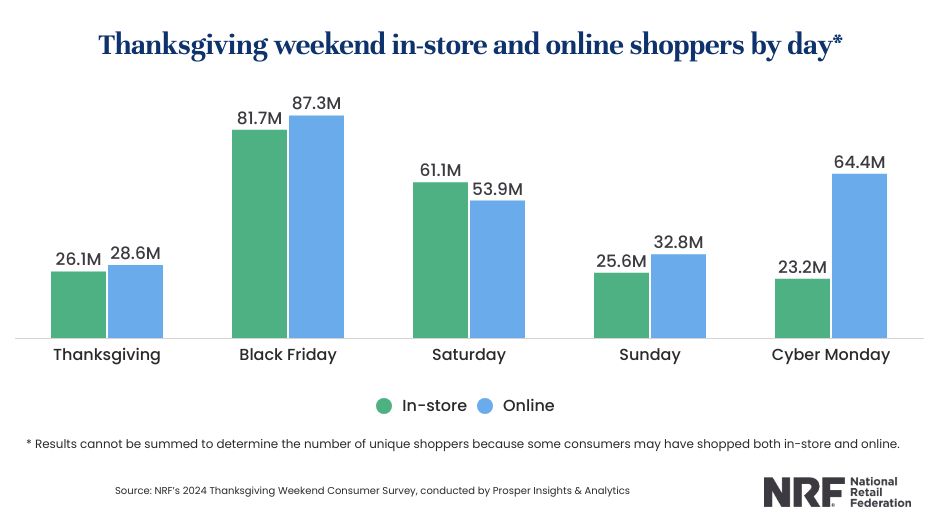
Holiday 2024 Shopping Insights: Black Friday and Cyber Monday Trends Shaping Retail
2024 has been an interesting year. Some industries are still feeling the impacts of the pandemic, sustained inflation is increasing the costs of living, and the outcome of the election has caused some economic uncertainty. But despite all this, the National Retail Federation (NRF) forecasted the holiday 2024 season to grow by 2.5-3.5% YoY even with five fewer shopping days.
Earlier this year, we asked 6,000 U.S. consumers about when, where, and how they plan to shop this year, and this is what they said:
- 68% said that Black Friday and Cyber Monday were NOT compelling this year (up from 54% last year).
- 45% said they planned to spend more than $1,000 on holiday shopping this year. This is a huge change from last year, where the majority (41%) said they’d spend less than $100 for the holiday season. Only 18% of shoppers planned to spend $1000+ last year.
- 43% said they planned to do their holiday shopping online (up from 37% in 2023). Further, a whopping 76% said they planned to shop more online this year than last year, an increase from 57% last year.
- 53% of consumers won’t start their shopping until December, an 8% increase from last year. And 32.5% claimed to wait until the week before Christmas to shop. Only 17.5% said they’d start shopping on Black Friday or Cyber Monday.
Some of these results make sense, but a few raise some eyebrows. Let’s take a look at what actually happened on Black Friday/Cyber Monday weekend.
Holiday 2024 Shopping Trends
Shoppers showed up, but mostly online
As expected, Black Friday and Cyber Monday weekend reached new highs. Initial reports indicate record-breaking shopper turnout for Cyber Week, with a notable shift toward online.
Total ecommerce spending rose 8.2% to $41.1B during the holiday weekend. On Black Friday alone, U.S. consumers spent approximately $10.8B online, which is a 10.2% increase from last year. On Cyber Monday—the day dedicated to online shopping—online spending reached a record $13.3B, a 7.3% increase from 2023.
But this online growth came at a cost to in-store visits. Some outlets are reporting up to an 8.2% decrease in in-store traffic on Black Friday this year. This is partially being attributed to the fact that holiday deals started earlier (and ran longer) than usual, creating less urgency around Thanksgiving.
According to National Retail Federation (NRF), a total of 197 million people shopped over Thanksgiving weekend, slightly less than last year’s 200 million. Here’s where it gets interesting: 126 million people shopped in-store (up from 121.4 million last year). And 124.3 million consumers shopped online this year, down from 134.2 million last year. This is counter to both our survey, which highlighted more interest in online shopping compared to last year, and online sales reports for the weekend.

The NRF hasn’t yet published in-store sales figures from the holiday weekend, but what we do know is this: Both online and in-store shopping were significant for Cyber Week 2024, but online shopping exhibited higher growth rates.
BNPL services were the new way to pay
Buy Now Pay Later (BNPL) providers have been sprouting up everywhere over recent years, but have become a common, and accepted, form of payment for consumers.
Our own database of more than 240 million U.S. consumer profiles showed that consumer interest in credit cards increased 303% in the week before Cyber Week. BNPL jumped 583% in the third week of November compared to the prior week. This interest—seen through online consumption behavior—was indicative of consumers preparing to spend during Black Friday and Cyber Monday.
And retail data from the holiday confirms this: BNPL drove nearly $1B, an all-time high for the payment method. More than three-quarters of these transactions occurred on mobile.
Mobile dominated online shopping
Speaking of mobile, reputable sources found that mobile shopping accounted for a staggering 57% of all Cyber Week sales, working out to about $7.6B in spend. At this rate, mobile is growing faster than overall online shopping growth.
NRF similarly found that 63% of Cyber Monday online shoppers used their mobile device, up from 55% last year.
This underscores the importance of mobile-friendly websites and the value of developing your own apps to expedite the shopping process. But marketers also need a mobile messaging strategies to reach consumers where they are.
Electronics, toys, beauty, and apparel won the markdown game
Our survey noted that product pricing, discounts, and coupons were the most important influencing factors for shoppers (followed closely by product selection/availability and unique offerings). As expected, this played out over the holiday weekend: Consumers were drawn to deals.
According to early reports, electronics were the most marked-down category for Cyber Monday, with an average discount of 30%, followed by toys. Makeup and apparel, however, had the biggest average markdowns at nearly 40%.
This also aligns with our Zeta Data, showing increased consumer interest in electronics and beauty, but also pet supplies (which saw content consumption jump 400% in November). Beauty interest dipped in October, but surged in November, up nearly 250%.
Marketers put in the work this Cyber Week
Of course, the holiday weekend wouldn’t have seen this success without marketing. Across all channels, retail marketers doubled down on their efforts to communicate holiday deals and encourage consumers to act, with intense competition.
When looking at the performance data within the Zeta Marketing Platform (ZMP), incorporating both our ESP and DSP, we found:
- 108% YoY increase in omnichannel digital messages served, showcasing expanded reach across both email and programmatic platforms.
- 30.4% YoY increase in DSP ad impressions served, emphasizing improved campaign scale and audience targeting.
- Video completions increased by 19.7% YoY, underscoring the effectiveness of our video campaigns as part of a multichannel strategy and demonstrating strong engagement with video content.
- Email campaigns achieved a 94% YoY increase in unique opens, with open rates peaking at 111 million on Black Friday, far exceeding industry averages and reflecting strong content relevance.
Consumer engagement hit an all-time high
Thankfully, this work was well-received. While most people’s inboxes overflowed during Cyber Week, they were helpful in ensuring the best deal. And engagement showed that consumers appreciate the effort.
A deeper dive within the ZMP revealed:
- Total consumer digital consumption increased by 192% YoY, driven by surging DSP CTR and record-breaking email opens and clicks.
- Unique email clicks surged by over 94% YoY, showcasing the impact of targeted, high-relevance messaging. And total clicks on emails reached 4 million, reflecting high consumer interest during peak shopping periods.
- Programmatic DSP impressions contributed to a cumulative 30.4% YoY growth for the week.
These results affirm the effectiveness of our comprehensive, data-driven omnichannel marketing strategy for retail marketing success.
Yet average spend per customer stumbled
In our pre-holiday survey of thousands of consumers across North America, 45% reported that they planned to spend more than $1000 on their holiday shopping this season. The majority last year said they’d spend less than $100, and this dramatic change caught our attention.
Last year, we were skeptical about the low expected holiday spend. And were proved correct. This year, however, it seems the average will actually land somewhere in the middle. NRF found that over Thanksgiving weekend, consumers spent an average of $235 on gifts, an increase of $8 over last year, primarily on clothing or accessories, toys, gift cards, food, and personal care categories.
But there’s still just over three weeks before Christmas to rack up more spend. Given that 32.5% of shoppers said they don’t plan to start shopping until the week before Christmas, we anticipate this average spend number to tick upward until Christmas.
What’s Next? Holiday Returns on the Rise
Now that Cyber Week is behind us, there’s still time before Christmas. Marketers need to stay the course, be proactive and consistent with your messaging, and start thinking about post-holiday.
Learn more about how Zeta helps retailers win holiday and beyond.
Want to see Zeta in action?


